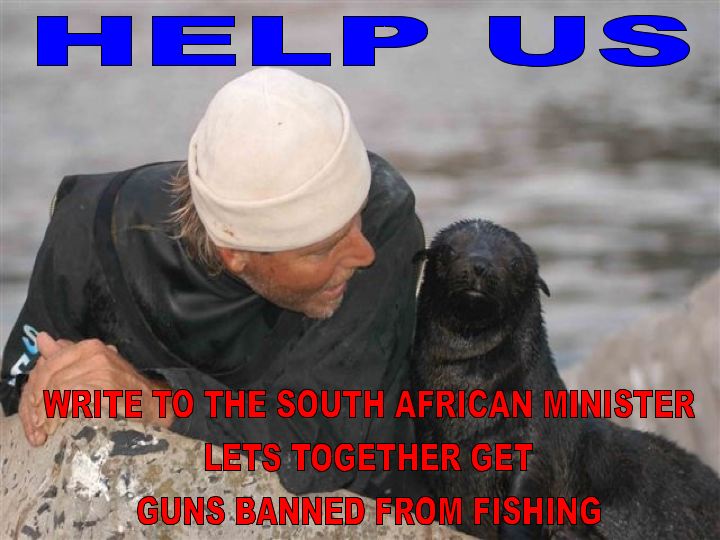SAVING THE CAPE FUR SEAL FROM EXTINCTION - ROBBEN ISLAND
SAVING THE CAPE FUR SEAL FROM EXTINCTION - ROBBEN ISLAND
27 FEBRUARY 06 SealAlert-SA sasealion@wam.co.za
Subject: Saving The Cape Fur Seal From Extinction - Robben Island
Dear All Seal Supporters,
Although Seal Alert-SA has been operating since 1999, mostly unfunded, except for a very few close supporters, with most of you, becoming involved in helping the Cape Fur Seals in the last 8 months. Thanks to you all, your generosity and kindness, has allowed Seal Alert-SA to move onto its next phase. A phase in which its core roots will still remain the Rescue of Seals, but in addition, a more physical intervention to ensure their future in the wild.
As you have all greatly assisted me, with boats, rafts, jetski's, rubber ducks, drysuits etc and now as well, becoming the "Guardians" of rescued seals, I feel it is important for me to advise, in an overall sense, not only where your hard earned donations are going on a day to day, rescue basis, but equally will we to able to effect meaningful change, or will this just involve the endless financial burden and commitment of rescue, with no end in sight.
Below is what we face, and at the end our plan, a plan which I would like to implement within two years.
To this end, I have started a online Petition :
http://www.petitiononline.com/RobbenSA/petition.html
The Cape Fur Seal, a species found nowhere else on earth, except along the southern African coastline, is in severe trouble. Over 1/3 to 1/2, of this species is dying, suffering or being abused each and every year. Entire cohorts of pups are dying. The daily suffering each individual seal is enduring is beyond written description. Commercial sealing alone has slaughtered over 3 million in the last 100-years.
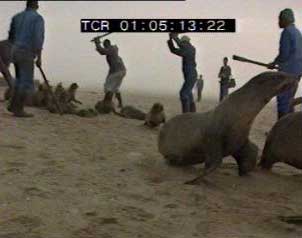
Present, meaning today, over 300 000 are dying from being clubbed, shot, entangled, drowned, beaten, abused or are starving to death. Daily, it is estimated over 1000 seals succumb to these multiple, mostly man induced threats, upon them. This is how the yearly death toll is made up;
* 60 000, 7-month old seal pups are clubbed to death on these mainland desert beaches, with wooden pick-axe handles, killing one in every two seal pups.
* 7000 bulls are shot simply for their penises.
* Up to 30 000 or 5000 new-born pups per concessionaire, are allowed to "squash" these babies whilst recovering shot bulls within the colony by truck
* Since 1988, re-occurring incidents of mass starvation of seals involving over 250 000 in each incident, or 25% of the total population, has become common with the 2005/2006 pupping season expected to be the worst yet.
* Increasing populations of Jackals and Hyena's are increasingly preying and becoming unnaturally dependent on foraging amongst mainland seal colonies, "stealing" thousands of its young seals.
* Less than 20% of the seals still occur in South African waters, yet these seals are forced to compete for "prey" from 65 000 trawl nets deployed, where one trawl, can result in up to 25 seals being drowned, in what is commonly termed "incidental drowning", thousands are being drowned annually.
* In South Africa alone, 30 000 commercial fishermen put to sea daily, many, if not all are armed with fire-arms, with which thousands of seals are shot illegally. The Minister refusing to ban this illegal practice, and with no arrests to date, refuses to prosecute these criminals.
* Due to being banned to unsuitable awash rocks, during pupping time, an estimated 40 000 baby seal pups are washed off, drowning in the process. Their survival rate for the past 30-years of protection, has been close to zero, and there has been no growth.
* Thousands of seals become weak, sick, injured or entangled, many of them "beach" themselves, where they will be removed and destroyed. There is no official rescue and rehabilitation facilities. Government in policy will not fund it.



After several years of working with this species in the wild, it is my belief, that unless we intervene, this specie will go the same way as the fore-father of the Zebra, the Quagga. The Quagga treated by farmers as vermin, the Quagga left the world so quietly that when colonial government finally put in place legislation to protect the animal, in 1886, it was unaware that the last Quagga in the world had died nearly three years before.
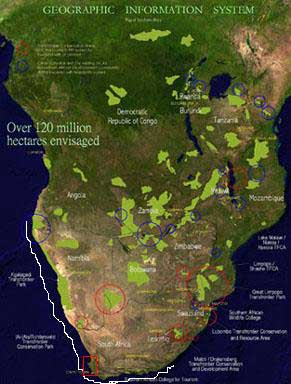
To understand the severity of this threat, even though their distribution range now covers over 4000 km, spanning 3 countries and there are over a million seals (As depicted by the White line). Their historic and original habitat, their breeding places that have evolved over millions of years, for a reason, in fact occurred along a coastline less than 300 km long. This small stretch of coastline, has already become extinct and has been so, for the last few hundred years. There is a reason for this, and this reason is that they are unnaturally and physically banned from breeding there any longer. From the location of the earliest fossil remains of a seal, dating back over 5 million years, in this small geographical region, known as the Cape West Coast, seals are now extinct from these historic islands (Depicted by the small red square).
Of the over 24 offshore islands, that are found within this total 4000 km range, 9 islands occur within this small region (Cape West Coast), whose total land surface area, account for over 88% or 880 ha of the total 1000 ha, protected offshore island land in southern Africa, for seals and seabirds. Even more important, just two of these islands, Robben (Seal) Island and Dassen Island, situated right next to each other, together account for over 78% of the land for all the islands in the whole of southern Africa. Islands which are barren in the sense of vegetation, human settlement or development, except for a few government researchers and visiting scientists, and the odd light-house personnel.
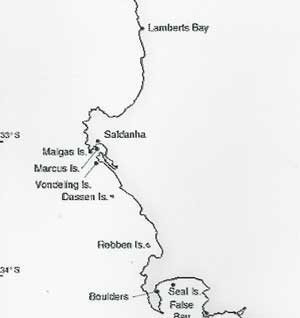
One of these islands, Robben (Seal) island, the largest at over 573 ha, famous for being the infamous prison of South Africa's former President Nelson Mandela, is today a wildlife sanctuary and a UNESCO world Heritage Site. This island, including the 8 others found along this 300 km of coast, and any island or rock greater than 2ha, has remained extinct and banned to Seals for well over 100-years. But, not other species, especially seabirds, and even some 23 species of mammal in some cases, who are not even indigenous to this region or islands.
To understand this clearly, in this historic region for breeding seals, these 9 islands (as shown above), Robben(seal) - (507 ha), Dassen (273 ha), Jutten (46 ha), Marcus (11 ha), Malgas (8 ha), Meeuwen, Schaapen, Vondeling (21 ha), Bird (2 ha), are all extinct to seals. No longer are they allowed to be the dominant species upon these islands. Their re-population prevented by physical "shooing" and on some, walls have been built,to facilitate seabird numbers and guano production.
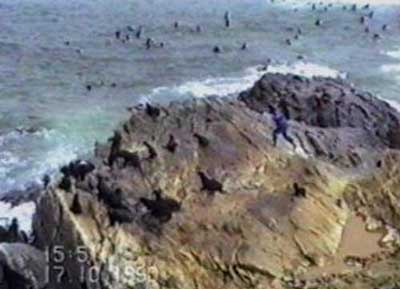
For the past one hundred years, there were many reasons for this, first is was physical extermination, through sealing, once seals were almost extinct, attention turn to seabird egg harvesting, once that declined, attention turned to guano (sea-bird droppings) for fertilizers, and then came the unnatural protection of fishing interests, and now, with many marine species in collapse, the conservation of single species, at the cost of others.
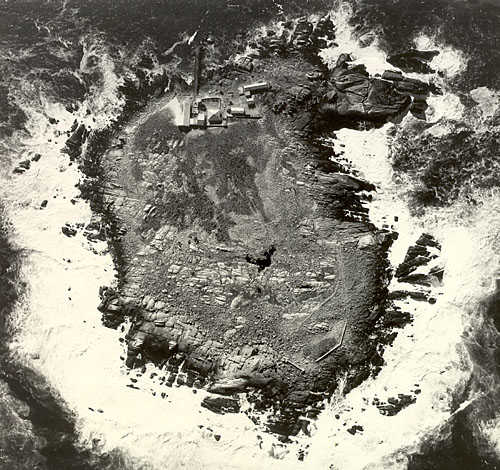
Illustrated further, the next closest seal breeding colony, Seal Rock in False Bay (Depicted by the smaller red circle - see below)), now the largest offshore unnatural seal breeding colony in southern Africa, is home to the birth of up to 19 000 pups each year. 100 years ago, this rock was not a seal colony. Using this current seal population density, their extinct/banned island Robben (Seal) Island, (Depicted at the top of the picture in big red circle), an island 250-times bigger, would have according to earliest historically explorer accounts, been home to the birth of over 5 million seal pups. Likewise, the second biggest island nearby Dassen Island (a little further to the north), could have been home to a further 2 million pups. Giving a possible total of 7 million seal pups on just two islands, in this historic region, consisting of 9 islands in total.

Today, as mentioned, and in fact, since official seal population survey's were first undertaken, in 1971, just over 30-years ago, the only seal pups recorded in this historically important region, are Robbesteen Rocks (<1ha), Jacobs Rock (<1ha) and Paternoster Rocks (<1ha). (All protected islands extinct). On these 3 awash rocks which account for less than 1% of the offshore protected island land for seabirds and seals, the following number of pups were recorded during the period, 1971 - 1997. A period that was supposed to present over 26-years of official protection and growth. Robbesteen (2425 - 1155), Jacobs (4804 - 1650) and Paternoster (758 - 1200). Overall in this region, once home to over 20 million seals, in 1971, there was just 7987 pups born, and in 1997, the last officially released population figures, this had dropped to 5015 pups born.
To truly understand, how unnatural and cruel this is, (the pic below), of a group of islands on our East Coast, where less than 3% of the seal population reside, visually detail, the physical banning and displacement of these seals from obvious natural historic habitats. Pictured above is a large island (centre), earmarked for exclusive seabird conservation, to the right, is an island named Seal Island, banned to seals, and on the far top left, the small rock (circled in red), is the only habitat seals are allowed to colonise.
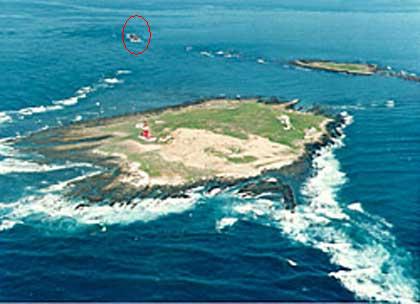
Pictured below, is the result, massive over-crowding, especially during pupping time and you can imagine what happens the moment the seas begin to rise, or high winds blow or storms roll in. This is the "nightmare" our wild seals are forced to endure day in and day out.
The result of this unnatural banning from large islands, is that there are now 16 similar low lying awash seal colonies, each one less than <1ha in size. In fact, every small offshore rock in southern Africa, has now become an ineffective seal breeding colony of huge suffering. These rocks today represent the offshore seal breeding population of the Cape Fur Seal in southern Africa.
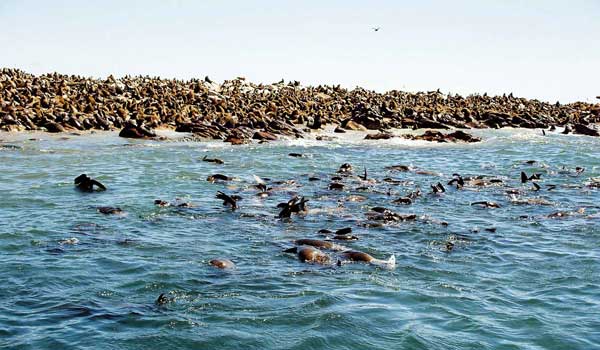
Right now, in this historic geographic group of 9 islands, almost all former seal breeding colonies, with all these 9 extinct to seals, 2 islands within this group are experiencing seals being shot by the very officials tasked with protecting them (Malgas and Bird Island). The excuse for this annual on-going slaughter is once again seabird conservation.
Seals on these 16 awash rocks, are forced to compete as well, against a commercial fishing fleet, that annually places over 65 000 large trawl nets in the surrounding seas. Banned and driven northwards, seals have been forced to colonise the mainland in northern South Africa and Namibia, in recent times, since 1940, simply due to a complete lack of offshore island space. Where today, 60 000 or one in every two pups, are clubbed commercially to death. A further 7000 bulls are shot commercially for their penises only, and in the process, each of the 6 concessionaires, is given a "by-catch" of 5000 baby seal pups, who may be ridden over by the trucks who enter the seal colony to recover the shot bulls.
Such is the suffering and plight of this species of seal. A specie, although called a "seal", which in fact it is not, as it has not yet evolved into a true seal, in which its propulsion is obtained from its hind flippers and can spend most of it's time at sea. Instead this species of seal, much further down the evolution chain, than true seals, dolphins, whales, sharks or fish, in that they are still bound to offshore land to rest, to mate, to pup and to moult. In fact, compared to other marine predators, Cape Fur Seals are at a distinct disadvantage, being required to rest for over 50% of their time on dry land, whilst their competitors, of which there are numerous, are able to forage almost continuously.
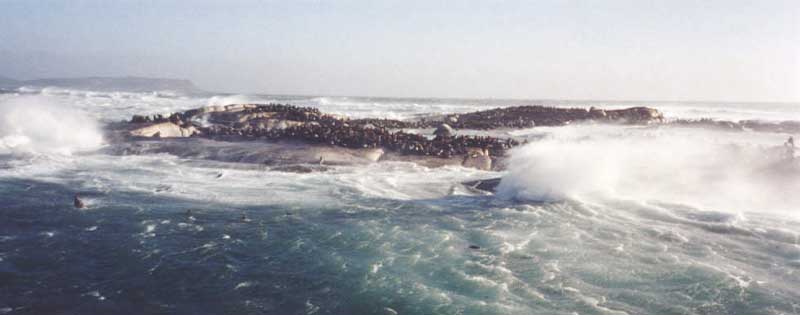
As can clearly be seen from the pic above, these awash rock seal colonies are ineffective in the future conservation and survival of this species. This is further confirmed by the only official population figures we have for these species, figures that do not go back, hundred's of years or even a hundred years, but in fact, just 30-years, first starting in 1971.
These 16 awash offshore seal rock breeding colonies, show that in 1971, a total of 47 466 seal pups were born there, even though in 1973, they became a protected specie, including all the islands and rocks off southern Africa. This specie, should have been growing at a steady 14% per year, (indeed even the more endangered African Penguin has been growing at 12% p.a over the last decade), with the only mortality being, mortality from natural predators, and a 32% new-born cohort pup failure rate. Instead, 26-years of protection, and the last official count in 1997, revealed that, on these 16 rock colonies, only 43 156 seal pups were now born.
At first glance, this figures may appear to look like a stable seal population or a slight decline. However the life-time of a seal is assessed to be around 30-years, a period too short to fully assess the full damage of these awash rock colonies. We are however, able to determine that although around 40 000 seal pups are born each year, with female pups reaching the breeding age of 5 years, that there has in fact been no growth. So bad is this situation, that we are in fact looking at a failure rate, through unnatural mass drowning of these pups each year, of close to 100%. At a natural and normal growth of 14% for this species, the number of pups born 26-years later should have increased to over 200 000, and not the 43 000 recorded.
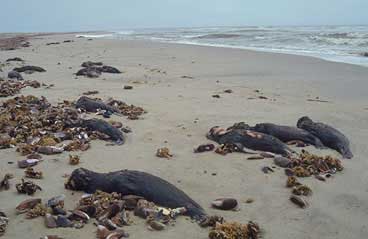
The bottom-line to all this, is that over one million seal pups have been born, in the last 26 years of protection, with most losing their lives unnaturally due to being forced to bred on these awash rock seal colonies. This part of the population only representing 17% of this species. With each colony already, overcrowded, and with only 10ha of total available land spread over all these 16 rocks, these seals in the Cape clearly have no future.
The remainder of the seal population likewise, have no future. Forced to bred on the mainland's, infected by mass death land based diseases, transmitted by jackals and hyena's, dying in their hundreds of thousands, for starvation from overfishing in the area, and with one in every two pups, all 60 000 of them clubbed to death, or the bulls shot, or the new-born's ridden over in "by-catch" quota's. These are the things that will lead to their extinction from this planet.
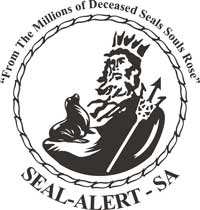
To me, whilst it is totally unacceptable, to go into a wild seal colony, around up and club and murder its young and bulls, or drown seals in their thousands in trawler nets, or allow 30 000 fishermen to shoot seals out of greed, or ignore the drowning of thousands of new-born pups each year, or allow our sea to become so overfished, that species millions of years in the making are now forced to starve to death, all the while we turn a blind eye to their daily suffering, and refuse to address their rescue, when this is supposed to be a protected species.
However, no matter how horrific these activities actually are, are nothing compared to forcing this entire species to alter their natural evolutionary path, a path that has been evolving off our shores for millions of years, a path that if unnaturally changed will most certainly lead to mass suffering and their extinction, as a wonderful species.
It is with the greatest respect to each one of you, and the contributions and sacrifices, that each one of you have made over these last few months, for you all have made it possible, to develop a plan, that will get these seals back on their evolutionary path.
Over the next two years, Seal Alert-SA plan is to undertake the following;
1.
2. Once we have perfected the Response, Rescue and Rehabilitation of "group" washed ashore new-born baby seals back into the wild successfully, and I am confident we can do so en mass. We will send the South African Marine authorities an ultimatum - "Select and Approve a major previously extinct Seal Breeding island off the Cape West Coast and facilitate the re-introduction of Cape Fur Seals there".
3.
4.
5. Failing which, Seal Alert-SA with a group of approximately 200 rescued baby seals, will select one or more major island/s of our own choosing, and physical "invade" this island/s, and re-claim it for these seals.
6.
7.
8. From this island, we will begin our "group" rehabilitation. It is then hoped, that within a 5 to 10 year period thereafter, that a fully functioning natural seal breeding colony, will slowly evolve, back as nature intended.
9.
10.
11. As the colony develops, it is our intention to slowly reduce our physical presence and rescue, and allow nature to take it's natural course.
This single "Act" of physical intervention, will have many positive benefits for the future of this species overall, namely;
1.
2. It will facilitate the "natural evolutionary" path of these seals once again, and so doing will,
3.
1.
2. Allow seals currently being forced to pup on unsuitable awash rocks, and which forces unnatural mass drowning of its new-born, to seek a more natural location to breed.
3.
4.
5. Seals that are currently experiencing over-crowding on these small awash rocks, to seek alternative habitat, to rest, mate and moult.
6.
7.
8. Facilitate the natural migration away from those unnatural "mainland sealing colonies", bringing with it, a natural end to "mainland commercial sealing".
9.
10.
11. Integrate Seal Conservation into an effective and meaningful policy of "National Protection" via legislation.
The benefits of this, single appropriate island, re-introduction, re-population or invasion, is immense, for as a migratory species, geographically chosen, almost every seal within southern Africa over the course of 5 to 10 years, will now have the opportunity, to re-locate back to it's historic breeding habitat, naturally.
Should every seal within southern Africa choose to do so, in the course and scope of the next decade or two, it will facilitate the following;
1.
2. Mass unnatural washing ashore or drowning of its new-born, will become a thing of the past, saving an estimated 40 000 seal pup lives a year, and allowing breeding seals a more natural mortality rate.
3.
4.
5. Prevent any further unnatural infestation of unnatural land based diseases from infecting the entire species.
6.
7.
8. Bring an end to the over 200 000 "mass death" of pups from starvation.
9.
10.
11. Allow alpha bulls to once again control large harems and effect their own "population control" by preventing weaker gened bull mating of cows, which has lead to a population explosion on the mainland and weakening of the gene pool of this species.
12.
13.
14. Bring a final end to mainland sealing, along the entire southern African coastline.
15.
16.
17. Allow meaningful observation and research, with which to develop further effective "protection and conservation" legislation.
18.
19.
20. Facilitate "mass disentanglement"
To truly understand how natural, feasible and appropriate this all is, should all the Cape Fur Seals in southern Africa, re-populate just one single island, for example, Robben (Seal) Island, this entire population, would only effectively occupy 32 ha or just 6% of this 573 ha island, the largest in southern Africa.
It is further hoped in time, that marine conservation officials, will soon see that seals do not pose a threat to other marine species, and finally allow once again the species off our coast to re-populate all the islands and rocks off our coast as nature intended, and finally allow full integration of these species, naturally.

In order for this to become I reality, I will have much work to do. The corner stone of which, lies in our "Rescue-A-Seal-A-Day" program, I hope at $500/seal, it will become well supported. As supporters of this "plan" may I ask each of you, to become seriously involved, take these wonderful seals under your "wing" so to speak. Open websites, pass this information on, raise funding, sell T-shirts or paintings, do whatever you feel, will bring about this change. I hope I can count on your future support.
If any of you are in disagreement, simply drop me an email, asking to be removed, and you will hear nothing further from me. P.S - I enclose my banking details for your records.
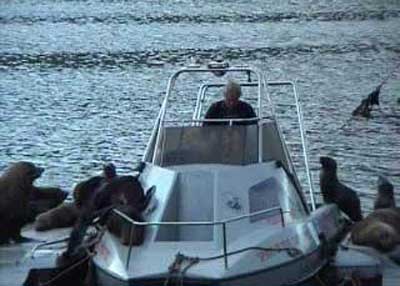
For The Seals, I am
Francois Hugo - Seal Alert-SA
sasealion@wam.co.za
My banking details as follows.
To mail a donation directly to Seal Alert-SA:
SEAL ALERT-SA
BOX 221
POSTNET
HOUT BAY
7872
HEREWITH IS FURTHER DETAILS FOR BANK TRANSFERS:
ZAR is South AfricanRand
More information to be able to send the money via internet:
SEAL ALERT-SA ACC : 911 2201 321
BRANCH CODE : 632 005
SWIFT CODE : ABSAZAJJ
BANK : ABSA
SA NAT.CLEARING CODE
BIC: (SWIFT-CODE) ABSAZAJJ
Bank name : ABSA
Address : DELPHI ARCH OFFICE PARK, RAATS DRIVE, TABLE VIEW
City/code : TABLE VIEW, 7439
Country : South Africa
